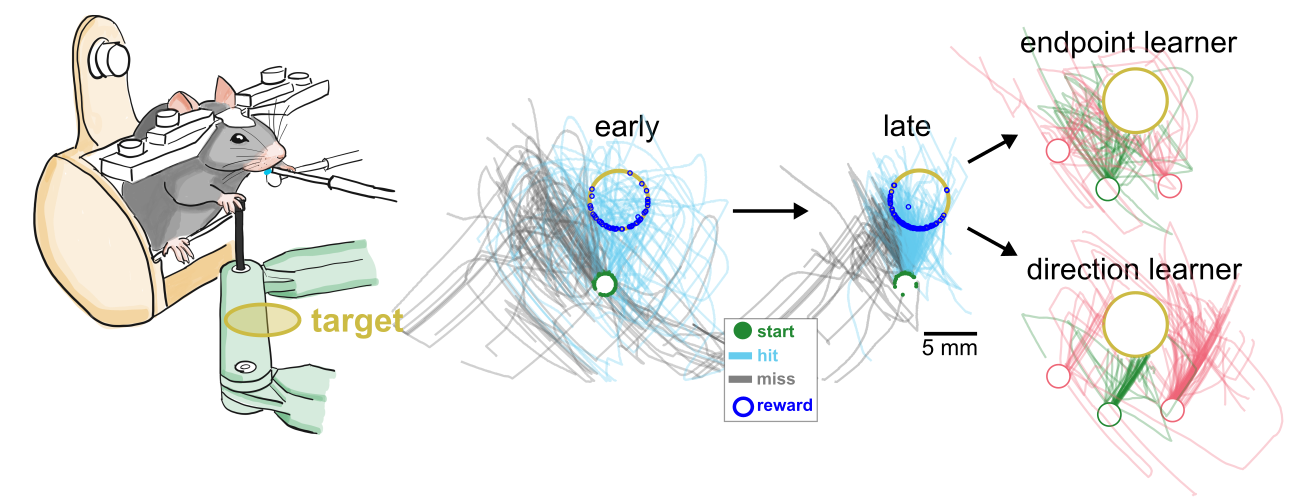Abstract:
Mammals learn a large repertoire of novel actions by refining variable movements into precise skills. The brain achieves this by assigning credit to movements that led to desired outcomes. Even for simple actions such as reaching to a spatial target, the brain could assign credit to the direction, endpoint target location, speed, etc. As such, different movement strategies may emerge across individuals, depending on what is assigned with credit.
My goal is to dissect the sensorimotor areas controlling different aspects of these movements, and probe what determines the learning of different reach strategies.
I developed a behaviour task in which head-fixed mice generate exploratory forelimb trajectories with a joystick and are rewarded when they hit a covert target in the workspace. As mice learn, they refine their reaches which become less variable in direction, tortuosity, speed, and targeting precision. We show that different aspects of the reach such as direction or speed are learned and controlled through distinct cortical and thalamic networks. For instance, sensorimotor cortex is required to generate reaches with high directional variability across different positions of the workspace, while a specific nucleus of thalamus is required to refine the overall reach direction.
But what reach strategies are mice learning? By relocating the start position in a small number of probe trials I discovered that some animals learned a direction-based strategy (move in the same initial direction from new starts), while others learned an endpoint-based strategy (guide the joystick into the target from new starts, adjusting their direction). Which strategy an individual animal learned correlated with the degree of spatial directional variability during exploration, the aspect of the reach controlled by cortex. We find that when we train reinforcement learning model agents in a similar task they also show this relationship between exploration and endpoint- vs. direction-learning bias. Overall, these findings suggest that the sensorimotor system learns different control strategies by exploring and reinforcing certain movement aspects during learning, and these aspects are likely generated by distinct circuits.

Biography:
Dr Alice Mosberger’s work dissects the interplay of the sensorimotor circuits that govern the skilled movements of our arms, particularly reaching movements. She has earned her PhD from ETH Zurich in Switzerland for her work in the field of spinal cord injury, under the supervision of Dr. Martin Schwab. Her main PhD work discovered that recovery of forelimb movements after corticospinal lesions is possible because axotomized corticospinal neurons re-route their control via the rubrospinal tract. Her work was supported by the Christopher and Dana Reeve Foundation. For her postdoctoral training, Alice moved to New York to join the group of Dr. Rui Costa at Columbia University where she continued her investigation of the sensorimotor circuitry underlying reaching movements in mice. She developed a novel spatial reaching task with which she discovered that individual mice learn a direction-based or endpoint-based reach strategy and has started to dissect the role of different sensorimotor areas in these target reaches using different neural recording, decoding, and manipulation techniques. Her postdoctoral work was supported by the Swiss National Science Foundation (SNSF), and she has been awarded a K99/R00 career transition award by the NIH BRAIN Initiative.
